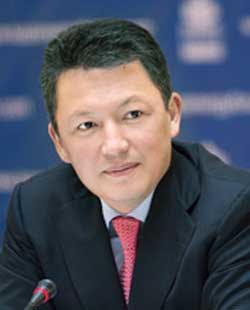KazEnergy chairman details Kazakhstan oil, gas development
Timur Kulibayev, former first vice-president of state oil company KazMunaiGaz (KMG) has been chairman of oil, gas, and energy association KazEnergy since it was founded in 2005. He talked with Oil & Gas Journal regarding Kazakhstan's oil and gas development plans during the KazEnergy Eurasian Forum earlier this month in Astana.
Kazakhstan has the second largest oil reserves and production among former Soviet Union republics after Russia, producing 1.6 million b/d in 2012, according to the US Energy Information Administration. Kazakhstan's natural gas production is also significant, reaching 1.3 tcf in 2010, but the vast majority of this gas is reinjected into oil fields to enhance production. The bulk of the country's reserves of both oil and gas, totaling 30 billion bbl and 85 tcf respectively, lie in three western Kazakhstan fields: Karachaganak, Kashagan, and Tengiz.
KMG is developing each of these projects in partnership with outside firms. BG Group, Eni SPA, Chevron Corp., and OAO Lukoil are its partners in Karachaganak Petroleum Operating BV. The North Caspian Operating Co.—comprised of Eni, Royal Dutch Shell PLC, ExxonMobil Corp., KMG, Total SA, ConocoPhillips, and Inpex Corp.—is developing Kashagan. KMG is developing Tengiz as part of Tengizchevroil (TCO), a partnership with Chevron, ExxonMobil, and LukArco.
Kazakhstan founded KazEnergy, an association of more than 50 major companies in the oil, gas, electricity, and uranium industries, including many of KMG's partners in the country's oil and gas fields, to better manage development of its resources.
The text of the exclusive interview follows.
OGJ: Development of the Kashagan field poses particular technical difficulties: very high-pressure gas, high sulfur content, and the simultaneously hostile and delicate environment of the northern Caspian Sea. There have been delays, but Phase 1 production now seems ready to start in 2013. How quickly do you anticipate being able to ramp up production at Kashagan? When might Phase 2 be brought on line? What are some of the current production targets for the field?
Timur Kulibayev: We expect Phase 1 to come on line [in March of] next year. We call it the industrial pilot phase. After that it will take probably a couple of years for us to fully understand how all of the facilities that we will have built behave, and how the reservoir itself behaves, to make further technological investment decisions.
Undoubtedly production and capacity at Kashagan will be expanded, but as of today there is no agreed and no approved expansion schedule. We are discussing a modular approach to expansion of our production, reaching 200,000 b/d [at the end of the pilot phase]. Our plans for the near future include reaching production of 450,000 b/d during Stage 1. When Kashagan reaches its full capacity it will produce about 1.5 million b/d.
Both the other investors and ourselves have a common interest in seeing Kashagan develop and will continue to pursue the most optimal solutions for this field in technological, financial, and environmental terms.
OGJ: As production grows, export capacity will have to grow along with it. Natural gas development has lagged oil relatively speaking, at least in part due to transportation constraints. First, what is planned in terms of expanding crude transport capacity? Second, is the current priority in terms of better using the country's natural gas resources to increase domestic infrastructure and consumption, or to improve export outlets?
Timur Kulibayev: Those are two very important questions. With regard to crude, as of today our main export routes include CPC [the Caspian Pipeline Consortium] and Atyrau-Samara (AS). AS transports 15.4 million tons/year and CPC, 34.2 million tpy. There is also the Kazakhstan-China pipeline, and the seaport of Aktau, which is our gateway to Baku and the Black Sea.
The CPC expansion project is ongoing. We plan to increase CPC's capacity through expansion and modernization to 67 million tpy by 2016. Work is also under way on the expansion of the pipeline to China, and we have plans to increase capacity there to 20 million tpy.
Our crude output plans dovetail with our transportation infrastructure development plans. We have diversified our export routes. Our main export routes go through Russia, but we also now have direct access to the Chinese market. We have access to the South Caucuses corridor, and in the future have plans to expand our participation in the Baku-Tbilisi-Ceyhan pipeline.
Regarding natural gas, our number one priority is domestic gasification. The bulk of our gas is associated gas, we don't have that much in terms of natural gas fields. Right now we produce about 40 billion cu m/year. Most of that is consumed by our oil producers for reinjection or other process needs. We use about 10 bcm/year to meet other domestic gas requirements.
At the same time we have a lot of potential in terms of gas transit. We already have the Central Asia gas pipeline crossing our territory, connecting central Asia with Russia. A transit pipeline to China also crosses Kazakhstan, with capacity of 40 bcm/year, which will reach 65 bcm/year upon expansion.
We are building a domestic pipeline to connect western Kazakhstan with southern Kazakhstan, linking our main producing region to our main consuming region. This will also tie into the transit pipeline to China.
Our domestic gasification program is successful and we also have a successful relationship with Gazprom. There is as joint venture with Gazprom called KazRosGas which will market our Karachaganak gas in Russia, after the two-thirds we will use for gas supplies domestically. We are also jointly addressing gas supplies to the rest of Kazakhstan, including the capital Astana. Our main priority will be on domestic gasification. But at the same time, we already have available an export infrastructure, and once our production is large enough to allow us to export it, we have gateways through which we will be able to do so.
OGJ: China and Russia have been key partners in Kazakhstan's energy development so far. How do you see your country's relationship with these nation's evolving? Is there a need to diversify export routes, particularly as regards transitting Russia?
Timur Kulibayev: China is a huge market for hydrocarbons from Kazakhstan. Kazakhstan is a land-locked country, with no direct access to the open sea. But at the same time we have direct access to China. And China to us is literally an unlimited ocean when it comes time to sell what we produce. This is an advantage for us, that we have a common border with China. Kazakhstan is also a very important logistics hub for Chinese products.
Russia is one of the largest producers of oil and gas in its own right. But at the same time, we have been successful in developing a strategy with Russia to enable the transit of our crude oil.
We don't at this point have any problems with transporting our hydrocarbons through Russia. Foreign investors, however, are always interested in backup options, including for export routes, which is why we are seeing a diversification strategy for these routes.
We also have access to Baku, and through Baku to the Black Sea. But the most profitable options for us right now are CPC and AS.
We already have a customs union with Russia, and are also embarking on a common economic area. We have very good cooperation with Russia which assures us of both unlimited supplies and uninterrupted transit.
OGJ: What mix of investments do you see moving forward between KazMunaiGaz, international oil companies, and other national oil companies in developing Kazakhstan's oil and gas resources?
Timur Kulibayev: KazMunaiGaz is a partner in many different ventures, including Kashagan and Karachaganak. KMG is also part of many different operations, including Tengizchevroil. TCO is a very successful example of project financing through partnership. This model has already been applied to the second phase of the project and we believe it will be used in the future with our partners to the mutual benefit of all parties.
KMG has always upheld its obligations and will continue to do so when it comes to large projects.

Christopher E. Smith | Editor in Chief
Christopher brings 27 years of experience in a variety of oil and gas industry analysis and reporting roles to his work as Editor-in-Chief, specializing for the last 15 of them in midstream and transportation sectors.
